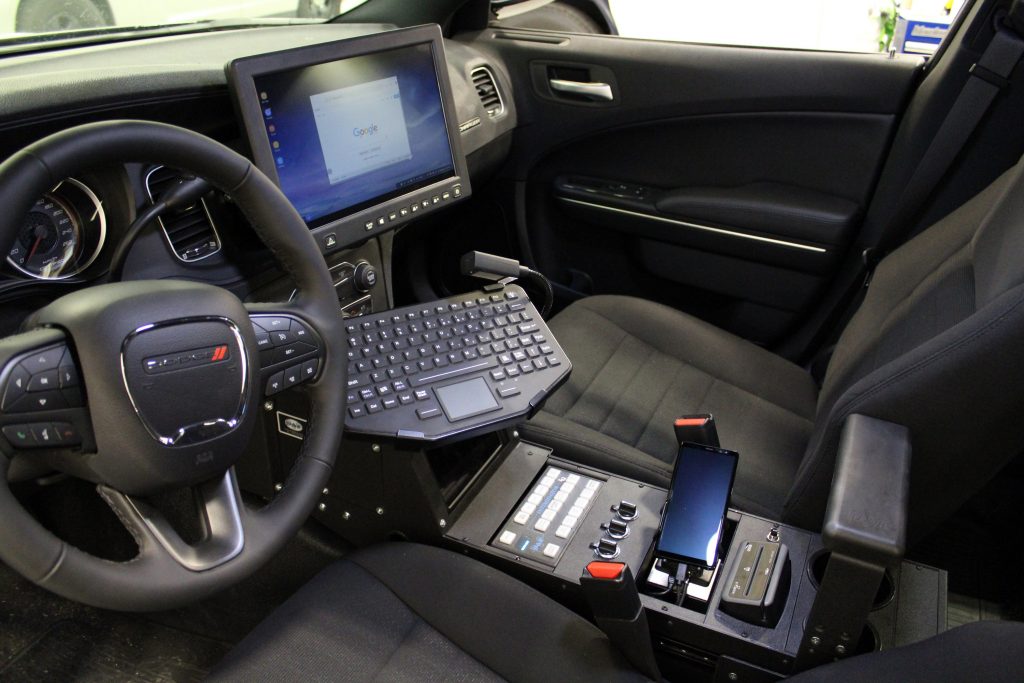
Features
Opinion
Technology
Mobile, adaptive connectivity is name of the game with Desktop eXperience Station
What if your officers could use one single computing device to access all their law enforcement applications and data? It’s a vision shared by many CIOs (chief information officers) and IT directors in the policing world.
February 27, 2018 By Harry Alkema and Gary Bauer
 When you plug your Samsung S8
When you plug your Samsung S8 To do this, you would need:
• Officers to be able to use a mobile device on the street and at crime scenes, in their vehicles, and in the station or detachment.
• 2Factor PKI (public key infrastructure) authentication for S/MIME (secure/multipurpose Internet mail extensions) encrypted email, secure browser access to your Ministry of Transportation portal, the Sex Offender Registry (SOR), Major Case Management, various police web apps, and for access to CPIC (Canadian Police Information Centre), Records & CAD (computer-aided dispatch).
• A Virtual Desktop Interface (VDI) for connectivity back to a Windows desktop for any legacy Windows applications.
• Native productivity apps, like O365 and weather, traffic, etc.
This is where the Samsung Desktop eXperience (DeX) Station could come in.
When you plug your Samsung S8, S8+ or Note8 into the DeX station, your phone goes dark and all the ‘already running’ apps on the phone are now presented on the connected monitor. This monitor could be 12.1 inches in the squad car or 21-plus inches on your desktop.
Now you have a full keyboard and trackpad/mouse for report composition and data entry — a much richer user experience than composing a 1,000-word report with two thumbs.
With a couple of USB ports on board, and an automotive or desktop USB hub, DeX can now connect you to peripherals like driver license scanners and thermal or laser printers.
The key here is a seamless transition from a crime scene (a victim’s residence, for example) to the police car, where you can complete your notes, clear the call, update your CAD status as available and proceed to your next assigned call.
At the end of your shift, you can take the phone out of the phone dock, leave the vehicle and get into the station, where you can again plug in your phone to a DeX station and close out any remaining tasks/reports before you book off and put your phone back into your pocket.
Darta Fleet Solutions has built a “concept police car” around a DeX, and notes it runs at about half the price of a traditional computer upfit with MDT/mount/modem/wiring harness etc. (It’s about two-thirds of the price of the upfit if printers and scanners are included.) The car has a 12.1-inch mil spec monitor — with 1500 nits or more for sunlight readability — and a temperature range from -40 to +85 degrees Celsius.
Add in a thermal printer, DL Scanner, ruggedized keyboard with trackpad, a USB automotive hub, and a phone cradle that will hold your S8/S8+ or Note8 in various ruggedized cases like the OtterBox or LifeProof, etc. Now tie all these pieces together with a DeX, and that lets you remove the computer from the car and cut out any trunk-based modem and dedicated wiring harness. In the station, imagine removing the computers and just keeping the keyboard/mouse/monitor and ethernet connection (to use the office network instead of your LTE data).
There are real benefits to a homogeneous family of devices; it’s possible to move any phone (plus its case) into any vehicle or desktop station.
The smartphone itself has secure email, calendar and contacts, and it can make and receive phone calls. The first of many native RMS (MPANiche from Mobile Innovations, for example) and CAD (Mobile Responder from Hexagon, as another example) apps are available on smartphones and there are native Office productivity apps: Word, Excel, PowerPoint, etc. However, there are not yet enough native apps to perform all of your duties without a Windows computer and that’s where a Virtual Desktop Interface (VDI) fills the rest of the bill.
VDI over LTE is just fine, and though it’s not enough on the phone, once that phone is connected to a fullscreen monitor and keyboard, that VDI session is not much different than that on a Windows desktop, except that it takes place at a fraction of the capital and ongoing maintenance cost.
There are still issues with pass-through of tokens and PKI Certs to that virtual desktop but various vendors are working on solving these problems, thereby enabling this vision instead of remaining among the last roadblocks.
The just released “Gartner Predicts 2017 Mobile Apps and Their Development” report forecasts that by 2022, 70 per cent of all software interactions in the enterprise will occur on mobile devices. Ensuring that officers can be productive on the move — not tethered to their desktop or reliant on paper-based processes — needs to be a focus for all agencies in 2018.
Harry Alkema is responsible for business solutions at Darta Fleet Solutions, based in Bolton, Ont. Contact him at harry.alkema@darta.ca or at 905-951-1940.
Gary Bauer is the CEO and founder of Mobile Innovations, a privately held company specializing in mobile computing, based in Niagara Falls, Ont.
Print this page